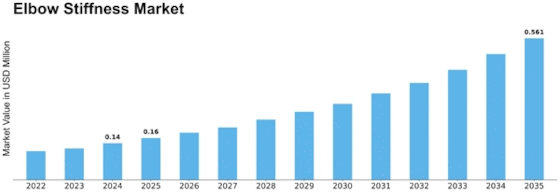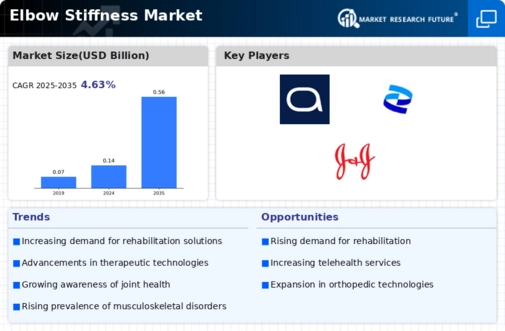Elbow Stiffness Size
Elbow Stiffness Market Growth Projections and Opportunities
The elbow stiffness market is heavily influenced by demography. Age, gender, and occupation are important here. Certain jobs that demand repetitive elbow movements may also affect market dynamics. Elbow stiffness is more common in older adults. The market is significantly impacted by arthritis, tendinitis, and bursitis. Thus, the incidence of these ailments affects the requirement for elbow stiffness therapies. The market for relevant treatments and therapies will develop as these ailments become more common. Modern medical technologies has helped grow the elbow stiffness market. Patients and healthcare professionals are more inclined to invest in treatments that are more effective due to advances in diagnostic tools, surgical approaches, and rehabilitation devices. Healthcare infrastructure quality and accessibility also affect the elbow stiffness market. Higher diagnosis rates and better treatment access fuel market growth in areas with well-developed healthcare systems. Elbow stiffness awareness and treatment choices are crucial. Education campaigns and healthcare initiatives boost patient engagement and demand for adequate healthcare services. Labor market conditions affect consumer and healthcare provider purchasing power. Healthcare spending rises when the economy is strong, benefiting the elbow stiffness business. However, as the economy slumps, unnecessary healthcare spending may fall. Regulations that restrict healthcare products and services affect market access and product development. To shape competition, elbow stiffness companies must comply with regulatory requirements. Multiple elbow stiffness treatment enterprises provide a competitive market. Cost, product efficacy, and brand reputation affect consumer choices and market share. Elbow stiffness medicines' availability and insurance coverage affect patient options. Comprehensive insurance makes patients more inclined to seek medical help quickly, which benefits the market. Elbow stiffness treatments are heavily impacted by orthopedic and musculoskeletal studies. Advances in treatments and medications boost industrial growth by improving efficiency. Cultural views regarding healthcare and lifestyle choices affect elbow stiffness diseases. Sitting, eating, and cultural traditions may increase or decrease the incidence of elbow-related disorders. Global health trends including preventive care and holistic wellness are influencing elbow stiffness sales. These changes are expected to boost demand for firms' products and services.


















Leave a Comment